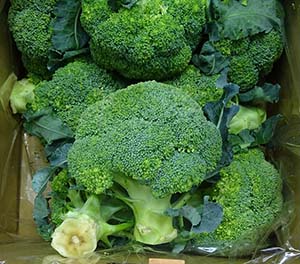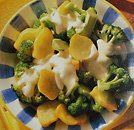Broccoli Nutrition Facts
Broccoli is a cabbage family vegetable grown for its nutritious flower heads. Its green or purple florets are known for several noteworthy, unique phytonutrients that have been found to have disease-preventing and health-promoting properties.
Botanically, the vegetable is a member of the large cruciferous (Brassica) family of vegetables, which also includes cauliflower, Brussels sprouts, cabbage, and arugula.
Scientific name: Brassica oleracea var. italica.
 |
| Broccoli head. |
Broccoli is a cool-season crop and demands fertile and well-drained soil to flourish. Technically, broccoli is categorized into two main types according to their appearance: heading and sprouting. The heading variety, Calabrese broccoli, forms a large, solid head, whereas sprouting types, purple sprouting broccoli, form many smaller heads or florets.
Once established, the broccoli plant bears flower heads about 4-10 inches wide, ranging in color from dark green to purple, depending on the cultivar type. The central thick stalk measures about 6-10 inches in length, and both the stalk and fleshy flower heads are edible.
Broccoflower (a hybrid of broccoli and cauliflower), broccolini (a mix of broccoli and Chinese kale), and Chinese broccoli (Gai lan) (Brassica oleracea var. alboglabra) are a few different hybrid mixes of broccoli established with other cruciferous family members.
9 Health Benefits of Broccoli
-
Broccoli is one of the very low-calorie vegetables, providing just 34 calories per 100 g. Nonetheless, it is rich in dietary fiber, minerals, vitamins, and antioxidants that have proven health benefits. The total antioxidant strength, known as the Oxygen Radical Absorbance Capacity (ORAC) of broccoli, is 1632 µmol TE/100 g.
-
Fresh broccoli is a storehouse of many phytonutrients such as thiocyanates, indoles, sulforaphane, isothiocyanates, and flavonoids like beta-carotene, cryptoxanthin, lutein, and zeaxanthin. Studies have shown that these compounds, by modifying positive signaling at molecular receptor levels, help protect against prostate, colon, urinary bladder, pancreatic, and breast cancers.
-
Fresh broccoli is an exceptionally rich source of vitamin C, providing 89.2 mg or about 150% of the Recommended Dietary Allowance (RDA) per 100 g. Vitamin C is a powerful natural antioxidant and immune modulator that helps fight against flu-causing viruses.
-
Furthermore, it contains good amounts of another antioxidant vitamin, vitamin A. A 100 g fresh head provides 623 IU or 21% of the recommended daily levels. Together with other pro-vitamins like beta-carotene, alpha-carotene, and zeaxanthin, vitamin A helps maintain the integrity of the skin and mucosa.
-
Vitamin A is also an essential factor for healthy eyesight and to prevent age-related macular degeneration of the retina (AMD) in the elderly.
-
Broccoli leaves (green tops) are an excellent source of carotenoids and vitamin A, containing 16000 IU of vitamin A per 100 g, carrying these compounds many folds higher than those in their flower heads.
-
Fresh heads are an excellent source of folates, containing about 63 µg/100 grams (providing 16% of the RDA). Studies have shown that consumption of fresh vegetables and fruits rich in folates during pre-conception and pregnancy helps prevent neural tube defects in newborns.
-
This floret vegetable is a rich source of vitamin K and the B-complex group of vitamins like niacin (vitamin B-3), pantothenic acid (vitamin B-5), pyridoxine (vitamin B-6), and riboflavin. Further, its florets also contain some amount of omega-3 fatty acids (Alpha-linolenic acid-ALA).
-
Furthermore, it is also a good source of minerals and electrolytes like calcium, manganese, iron, magnesium, selenium, zinc, potassium, and phosphorus.
| Principle | Nutrient Value | Percent of RDA |
|---|---|---|
| Energy | 34 Kcal | 1.5% |
| Carbohydrates | 6.64 g | 5% |
| Protein | 2.82 g | 5% |
| Total Fat | 0.37 g | 1% |
| Cholesterol | 0 mg | 0% |
| Dietary Fiber | 2.60 g | 7% |
| Vitamins | ||
| Folates | 63 µg | 16% |
| Niacin | 0.639 mg | 4% |
| Pantothenic acid | 0.573 mg | 12% |
| Pyridoxine | 0.175 mg | 13% |
| Riboflavin | 0.117 mg | 9% |
| Thiamin | 0.071 mg | 6% |
| Vitamin A | 623 IU | 21% |
| Vitamin C | 89.2 mg | 149% |
| Vitamin E | 0.17 mg | 1.5% |
| Vitamin K | 101.6 μg | 85% |
| Electrolytes | ||
| Sodium | 33 mg | 2% |
| Potassium | 316 mg | 7% |
| Minerals | ||
| Calcium | 47 mg | 5% |
| Copper | 0.049 mg | 5.5% |
| Iron | 0.73 mg | 9% |
| Magnesium | 21 mg | 5% |
| Manganese | 0.210 mg | 9% |
| Selenium | 2.5 µg | 5% |
| Zinc | 0.41 mg | 4% |
| Phyto-nutrients | ||
| Carotene-β | 361 µg | -- |
| Crypto-xanthin-β | 1 µg | -- |
| Lutein-zeaxanthin | 1403 µg | -- |
Choosing and Storing Broccoli
You can find fresh broccoli heads year-round. When picking broccoli at the market, opt for ones that are fresh, bright, compact, and have firm-textured flower heads with a rich flavor.
Avoid broccoli with overmature florets that have yellow flower buds, excessive branching, or hollow stems. If possible, purchase from nearby organic farms to maximize health benefits.
Once you're home, rinse the flower head by submerging it upside down in salted water for up to 30 minutes. Then, wash it again under cold running water before using it in cooking to remove any pesticide residues and dirt. Clean broccoli greens in the same manner as other greens, such as spinach.
Enjoy broccoli while it's fresh. Alternatively, store it in the refrigerator wrapped in a zip pouch, where it can stay fresh for a few days.
Preparation and Serving Methods
The fleshy floret heads, stalks, and leaves of broccoli are all edible. Use a paring knife to trim away tough stalks and thick leaves.
 |
| Broccoli recipe(photo: The essential vegetarian cook book) |
You can enjoy young, tender broccoli heads either raw or as a salad.
The flower heads of broccoli are highly sought-after in stir-fries, whether on their own or combined with other vegetables, beans, and poultry. They make mouth-watering recipes when mixed with sauce, oil, onions, pepper, and garlic.
Enhance rice, pasta, and pizza dishes by adding broccoli florets.
Prolonged cooking, boiling, and microwaving of broccoli have been found to destroy heat-sensitive vitamins like folate, antioxidant vitamins like vitamin C, and some of its anti-cancer phytonutrients. Alternatively, employing other brief cooking techniques such as steaming and gentle braising may not significantly alter the composition of these compounds.
Safety profile
In a manner akin to other Cruciferous family vegetables, broccoli contains goitrogens that have the potential to induce swelling of the thyroid gland. Therefore, individuals with thyroid dysfunction should exercise caution and avoid excessive consumption. However, broccoli remains a safe choice for those in good health. (Refer to our medical disclaimer for further information).
Also read ≻≻
Read further on:
≺≺ Do Potassium-Rich Foods Help Lower Blood Pressure?
≺≺-prostate.
≺≺Broccolini nutrition facts.
≺≺Chinese broccoli (Gai lan) nutrition facts.
≺≺Choy sum (Chinese flowering cabbage) nutrition facts.
≺≺Komatsuna nutrition facts.
≺≺Broccoli rabe nutrition facts.
≺≺Cauliflower nutrition facts.
≺≺ Back to Vegetables from Broccoli nutrition. Visit here for an impressive list of vegetables with complete illustrations of their nutrition facts and health benefits.
≺≺ Back to Home page.
Stanford School of Medicine Cancer information Page- Nutrition to Reduce Cancer Risk (Link opens in new Window).